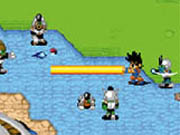Dragon Ball Z: The Legacy of Goku is an action role-playing game for the Game Boy Advance. Its storyline condenses the entire 92 episodes of the Saiyan Saga into a single video game. Fans of the series will enjoy the subject matter and lengthy list of cameo appearances, but devout RPG players won't find anything to sink their teeth into--since the game is short, easy, and lacking in imagination.

You assume the role of Goku, who is on vacation to visit Master Roshi on Turtle Island. Soon after his arrival, Raditz--Goku's long-lost Saiyan brother--shows up and kidnaps Goku's son, Gohan. This sends you on a quest to rescue Gohan, which the game ultimately forges into a succession of lengthy scavenger hunts and battles against notable series villains. All of the big names are present, including Vegeta, Frieza, Krillin, Piccolo, and King Kai.
Amusingly, while the animated series draws criticism for spreading single battles across multiple TV episodes, the entire quest in Dragon Ball Z: The Legacy of Goku lasts a mere four hours. If you spend time gaining experience by fighting generic Saiyans and other creatures, it might take five. The game's scarcity of depth isn't for lack of locations, since it has more than 16 TV-inspired stages to explore; it's because there is very little in the way of character interaction, item trading, or side quests. Before you reach the final battle, there are literally only 26 different tasks to complete.
Some players will also find that the game lacks challenge. Although you begin the quest at risk of being mauled by sand crabs and wolves, eventually you'll be able to vanquish the majority of enemies with a single hit from Goku's fireball attack. Thankfully, though, the controls are similarly easy. All four of the GBA's buttons are used to enable Goku to punch, fly, and talk, as well as swap between and cast a number of special "ki" attacks. Even if Goku doesn't have all of his abilities from the TV series, his fans should be pleased to know that he can cast fireballs, blind opponents with a flare, and launch his superspecial King Kamehameha attack.
Other than the time you'll spend fighting random creatures, Goku's journey is more restrictive than it is creative. The majority of side quests involve retrieving misplaced items for local residents, such as rescuing an errant toddler or gathering stones for a makeshift bridge, but trading for or seeking items is never an issue, since nonplayer characters usually tell you exactly where to find the necessary objects. Once you've completed a task, it's impossible to backtrack to previous locations, which further limits any sense of freedom you'll feel while playing the game. As for bosses, there are really only two--Vegeta and Frieza--although you'll have to defeat their henchmen as well. This is all a far cry from what you'd get in a typical RPG, which usually involves excessive backtracking, plenty of bartering, and numerous side quests.

The most impressive aspects of Legacy of Goku are its visuals and audio. Graphically, all of the backgrounds are colorful and full of gratuitous detail, while character sprites are large enough so that you can clearly discern who they're supposed to be. Character animation is choppy, but you never really notice it since the majority of action involves walking or casting fireballs. The game does lose a few style points for its perspective, as Goku often sticks to skyward portions of the 2D sprites that compose the 3D landscape. Music and sound effects are straight from the TV series and even include speech samples for a number of characters.
For an RPG, Dragon Ball Z: The Legacy of Goku is barely worth a second look on the shelf next to Nintendo's Golden Sun and Capcom's Breath of Fire II. Nevertheless, for a product based on an animated series and one that will be purchased by primarily younger audiences, it is a decent inroad into one of the world's most beloved cartoons.